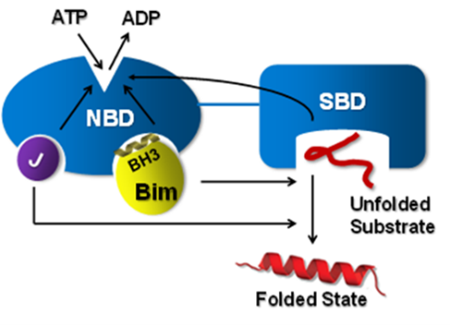
Journal of Biological Chemistry: The chaperone Hsp70 is a BH3 receptor activated by the pro-apoptotic Bim to stabilize anti-apoptotic clients
Authors: Zongwei Guo, Ting Song, Ziqian Wang, Donghai Lin, Keke Cao, Peng Liu, Yingang Feng, Xiaodong Zhang, Peiran Wang, Fangkui Yin, Jian Dai, Sheng Zhou, Zhichao Zhang
Abstract
The chaperone heat shock protein 70 (Hsp70) is crucial for avoiding protein misfolding under stress, but is also up-regulated in many kinds of cancers, where its ability to buffer cellular stress prevents apoptosis. Previous research has suggested Hsp70 interacts with pro-apoptotic Bcl-2 family proteins, including Bim and Bax. However, a definitive demonstration of this interaction awaits, and insights into the structural basis and molecular mechanism remain unclear. Earlier studies have identified a Bcl-2 homology 3 (BH3) domain present in Bcl-2 family members that engages receptors to stimulate apoptosis. We now show that Hsp70 physically interacts with pro-apoptotic multidomain and BH3-only proteins via a BH3 domain, thereby serving as a novel BH3 receptor, using in vitro fluorescent polarization (FP), isothermal titration calorimetry (ITC), and cell-based co-immunoprecipitation (co-IP) experiments, 1H-15N-transverse relaxation optimized spectroscopy (TROSY-HSQC), trypsin proteolysis, ATPase activity, and denatured rhodanese aggregation measurements further demonstrated that BimBH3 binds to a novel allosteric site in the nucleotide-binding domain (NBD) of Hsp70, by which Bim acts as a positive co-chaperone to promote the ATPase activity and chaperone functions. A dual role of Hsp70's anti-apoptotic function was revealed that when it keeps Bim in check to inhibit apoptosis, it simultaneously stabilizes oncogenic clients including AKT and Raf-1 with the aid of Bim. Two faces of Bim in cell fate regulation were revealed that in opposite to its well-established pro-apoptotic activator role, Bim could help the folding of oncogenic proteins.

https://doi:10.1074/jbc.RA120.013364